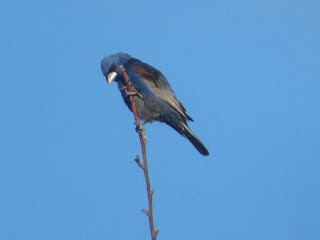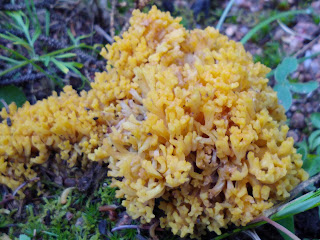Identifying animals in the bosque is like opening a set of nesting dolls. Each new observation leads to other, more nuanced observations. While going down rabbit holes is not productive in a business, or college setting, there are unexpected rewards for the receptive mind. The simple process of thinking creatively is hard to practice, yet valuable for it's own sake. Much like the study of nature.
Most tadpoles are deep black from a skin pigment. The same pigment gives bird feathers extra strength and performs a broad range of functions in humans.
Melanin is apparently being produced in this tadpole (found in heavy clay substrate) as seen in the small spots along the tail, the eyes and the mouth, but the body is basically transparent, no idea why.
Even white mushrooms have the same chemical in their tissues. Chemists are learning how to produce
melanin in quantity as a structural preservative for woods, and many other applications. The brown coloration in this white mushroom is from melanin, the same chemical found in my freckles.
The moisture the mountains in New Mexico have experienced this year are producing a plethora of fungi fruiting bodies called mushrooms. This is a coral fungus. apparently it is edible. Not particularly tasty according to those in the know.
The heavy weed growth that home owners so hate in Corrales is a boon to the cattle ranchers grazing on public lands in more montane areas.
Cattle is a complex issue, but undeniably has a long history in New Mexico. The problem is in the conflicts with critical habitat such as that used by the
New Mexico jumping mouse.
It seems odd to us to read about the violence of the "
fence cutting wars" that barbed wire brought to New Mexico public lands. But echo's of the fight over land use continues today, especially between rural and urban land use.
This snake was run over by a car and then decapitated. The species is a coachwhip and no danger to humans at all. While farmers and ranchers have a reputation for snake cruelty, the fact remains that roads are by far the bigger risk to snakes and increased urbanization is leading directly to more dead snakes.
Threats to woodland can also be far more insidious. The long horn wood borer beetle is not usually a threat in a large forest, but in small areas the numbers of beetle can quickly reach numbers that will cause serious damage to a prized solitary tree in a garden.
A related beetle is this popular borer. The beetle did affect drought weakened trees the most. However, Stories of them causing actual tree death seems mostly anecdotal. This would be a woodpecker's dream meal. The flickers and woodpeckers should be returning soon as autumn draws in.
These larva cause galls along tree branches, but the tree can also shed these branches when infestation first starts, especially in the autumn. The cottonwood tolerates a wide range of organisms as keystone species of the Bosque ecosystem.
This is a species of crescent butterfly. the commonly seen insects are starting to become smaller as the evenings become cooler. Butterflies are still quite numerous and active at the moment. Why these particular insects are so spectacular in color is a bit of a fake fact, because almost all insects are beautifully colored, if they need to be.
Like most wasps this species of narrow waisted sand wasp does not sting people as the stinger is modified from an egg laying organ and is used in this species for injecting into a paralyzed caterpillar that is stored in an underground larder.
This rather startled looking bird is a night heron, one of the harbingers of the cooler season. This usually shy bird benefits from the dense foliage to hide in during the mid day.
Adult wasps usually feed on nectar, while the grubs feed on caterpillars. This is a tarantula hawk wasp that hunts tarantulas for egg laying. It is not nearly as scary as it's reputation or name.
The grasshoppers are thriving right now and many species are growing the wings they need to begin migrations. The tiny wing cases are just visible on this insect's back.
The walking stick insect is usually common, but not seen much due to the great camouflage. When they begin migrating to different plants, they stand out against the asphalt.
Wasps can be tricky to identify because they are so diverse. This insect is clearly not a stripy murder hornet, but is actually a wasp.
This insect is actually a type of ant. The common velvet ants we see in the arroyos are actually just one of group of 150 different species and belong to daytime velvet ants. This is a male nocturnal velvet ant and looks very much like a wasp, but has the wrong shaped antennae and stiff hairs on the thorax.
This wasp looking insect is actually a black soldier fly. The adults have no mouth parts because they don't live very long. The grubs are found in compost and are considered beneficial, especially when compare to the annoying flies
mud dauber wasps put spiders in small clay pots high up under the overhangs of houses. Like most wasps they use insects to feed their young, but they themselves feed on pollen and nectar. They are pretty shy but would defend a nest aggressively.
Scorpions are rarely as dangerous as portrayed. In many parts of the world, collecting scorpions is diverting entertainment for small kids (including this one). They are docile, predictable, and their stings are no worse than that of a wasp.
This spider is some wolf spider species and much larger than the picture would suggest. Some of these arachnids hunt tarantulas that are a similar size to them. The sturdy legs suggest this is not a fast moving hunter
The narrow legs of this smaller Carolina wolf spider show it is a much faster hunter. It is common in the early fall because these spider stalk their prey in the open.
Cockroaches are synonymous with human habitation and have traveled around the globe with them. This cockroach is gradually replacing the oriental cockroach in the southwest and expanding it's range since it was first discovered in 1978 in the US.
This cicada was stung and paralyzed by a cicada killer wasp, but it was far too big for the insect to fly off with it. The wasp will likely return to try again once I have finished taking pictures.
Beetles can be impressively patterned if we take the time to get close and observe what is right under our noses. Soon enough the weather will turn colder and these creatures will vanish for months at a time. This is a bumble flower beetle.
There are also many plain butterflies, our eye is simply more likely to dwell on those that are big and brightly colored. Of which, this specimen is neither. Its name is "Least skipper"
Legume plants are a very special type that can grow in poor nitrogen soil by forming symbiosis with bacteria in their roots. The flowers are very distinctive in this family. These plants are also edible but often over looked. The family was also used by Gregor Mendel to as a model organism to begin the process of understanding DNA in the late 1800's.
Austrian Peaweed is in the legume family too. It is one of the many weed seeds that get introduced in new areas with alfalfa seeds. The bosque has a far wider range of plants than the casual observer would surmise.
Russian Knapweed is a noxious weed in the Western US that can affect horses and take over areas with vegetative growth. A pretty flower that spreads using runners instead of seeds and packs quite a chemical wallop. It is in the aster family
The sunflowers don't seem to get noticed except in late summer, where fields of planted flowers have begun to replace local U-pick chili and raspberry patches. There are farmed sunflowers, but most seen in the bosque are left over from bird feeding blends. The wild seeds attract many small birds during the winter.

Purple bindweed is another type of morning glory that is native to Texas. It goes by many names and is easily confused with other similiar types. It is reviled by many, but resists all attempts are elimination. Governmental land use guidelines only "suppress" its activity. It is a spectacularly beautiful and short lived flower. This confusion of who to identify a plant by it's usefulness is at the heart of many arguments between different land users, and different experience levels. Another layer of nesting dolls opens up when we consider how to view an organism within the existing landscape. Sunflowers are weeds, and so are morning glories. But one is a weed, and the other is not....





























































